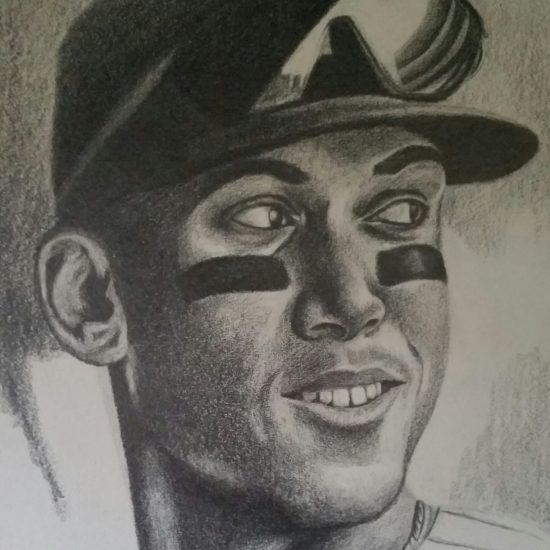Batting average and OPS are great, but they are just a piece of the picture. Context is critical. That’s where PLV can help us assess hitter performance with intuitively scaled metrics like decision value, contact ability, and power. Are they swinging at good pitches to hit? How do their skills compare to the league average?
For pitchers, PLV assesses things like location, velocity, height-adjusted approach angle, and more than I can list, to grade pitch quality.
Our approximate benchmarks for sample size are 400 pitches for DV, 200 swings for contact ability, and 75 BBE for power. For Pitchers, PLV and PLA stabilize at around 500 pitches.
You can find Nick’s primer here if you’re new to PLV. All the metrics are normalized to 100. Decision Value (DV) has also been further broken down this season into zDV (inside the strike zone) and oDV (outside the strike zone).
This week, I wanted to run down some stuff that has caught my eye over the past three months, and things that I’m looking for in the second half from breakouts, bounce-backs, slumping stars, to trade candidates. We’ll go position by position.
Outfield
We’ll start in the outfield with our cover star Brent Rooker, who has given A’s fans something to watch other than Mason Miller making hitters look silly. Rooker is 14th among qualifiers with a .380 wOBA and .890 OPS. He’s the 75th ranked player on Yahoo! standard 5×5, and yet he’s only rostered 80%. Sure, lots of small, less active leagues but it indicates how he’s being overlooked.
He’s adding a ton of power. His 144 power (176 BBE) is second among players with at least 150 BBE, right on par with Shohei Ohtani’s 142 (255 BBE). Sure, that might regress, but the good results are validated. Does he get traded at the deadline? He’s someone who could be a wrecking ball in a good lineup.
Aaron Judge is first in power. Can you believe it? His 156 leads Rooker by a little less than a standard deviation, which is roughly 15 points.
On the opposite end of the spectrum is Corbin Carroll, whose .613 OPS is sixth from the bottom among qualifiers (Orlando Arcia; .577 OPS). Last year’s NL RoY has seen his power plummet from 105 to about a standard deviation below the average at 85 (266 BBE) this season.
Julio Rodríguez is six spots above Carroll with a .632 OPS. Unlike Carroll, J-Rod has shown above-average pop (110; 249 BBE). That’s not all that different from last year (112; 476 BBE). His contact ability has dipped a little from 102 to 94. Ditto with his swing decisions (86 DV to 80 DV). Still, he makes all the sense in the world as a second-half bounceback. One thing’s for sure, he’s swinging hard.
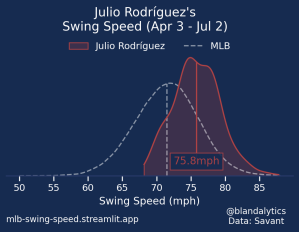
What do the Braves do with the leadoff spot? Jarred Kelenic has produced well, hitting .292 with a .873 OPS since becoming Atlanta’s leadoff hitter on June 15th. He’s added some power (108; 168 BBE). But the rest of his profile, especially contact-ability (81) is below average.
What happens when Michael Harris II comes back? He was Brian Snitker’s leadoff man before a gimpy hamstring sent him to the IL. Harris brings all sorts of tools to the table, but his swing decisions were perilously bad this year (69; third-worst among hitters with at least 500 pitches faced).
Steven Kwan leading baseball with a .358 batting average isn’t surprising but his having nine home runs through 63 games is not something I had on my bingo card. Yet, here we are. He’s upped his contact ability (126; 132) and power (77; 85). He’s still about a SD below the average but gains in both are pretty cool to see.
The recent promotion of Heston Kjerstad creates somewhat of a logjam in the Orioles lineup. Ryan Mountcastle (107 Hitter Performance) and Ryan O’Hearn (112 HP) have performed well, locking up the 1B/DH spots most nights. Colton Cowser made a lot of noise early and has shown exceptional power (126; 163 BBE) but has struggled lately with questionable contact ability (84). Cedric Mullins on the other hand has been the opposite; good contact (112) but not much power (91; 196 BBE), so it’ll be interesting to see how Brandon Hyde plays this out.
It kinda sorta feels like the bloom has fallen off the rose for Jazz Chisholm Jr. who is 73rd among qualifiers with a .733 OPS and 76th with a .318 wOBA. Now, we’re hearing him come up in trade talks. To his credit, he’s improved his contact ability quite a bit this year from 78 to 96. However, his power output has declined from (116; 233 BBE) to (108; 226 BBE) and his Decision Value remains below average (94 last year, 92 this year). Maybe a change of scenery is the spark he needs, but right now his profile seems more bark than bite.
Lars Nootbaar recently returned from the IL and I still believe in him. Not that he’s listening. He’s a passive hitter with a penchant for excellent swing decisions (123 DV) with above-average contact ability (107) and pop (107; 107 BBE). We’ve seen Brandon Nimmo take off recently, and I think Nootbaar cuts a similar profile who could boom in the second half.
Wyatt Langford has certainly held his own as a 22-year-old rookie with a .752 OPS that would be tied with Carlos Santana for 58th among qualifiers. Langford was billed with big power as one of baseball’s top prospects but it hasn’t materialized quite yet (96; 187 BBE). Still, his swing speed demonstrates the raw power lurking in his bat.
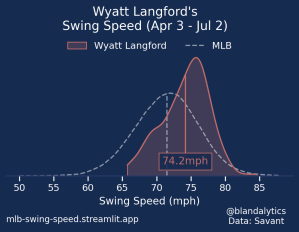
Second Base
As a Ketel Marte aficionado, it warms my heart to see him leading qualified 2B with a .851 OPS and .360 wOBA, just barely ahead of Jose Altuve (.823 OPS, .359 wOBA). We’ve seen Marte’s power surge about a standard deviation from (90; 460 BBE) to (106; 271 BBE). He’s got a shot at matching his career-high 32 dingers from 2019.
On the opposite end mired in the sunken pit of despair is Gleyber Torres, whose .285 wOBA ranks 18th among qualified 2B. His swing decisions are quite good (116 DV). However, his contact ability has dropped from 102 to 91. His power has also dropped from 106 (499 BBE) to 99 (237 BBE). An unrestricted FA at the end of the year, Torres has much on the line in the second half.
Third Base
One of last year’s breakouts, Jake Burger, has floundered thus far with a .613 OPS, fifth-worst among all qualified hitters. Like Harris II, swing decisions seem to be the problem. Burger’s swing speed is in the 90th percentile but his power has dropped this year from 121 (343 BBE) to 107 (187 BBE). He’s an interesting potential trade target for the Marlins. However, he’s arb-eligible through 2028, so there’s that.
Anthony Rendon is finally back! What? You’re laughing. No, he didn’t retire. As someone who enjoys mayhem, the idea of Rendon being fantasy-relevant again is a little amusing. He showed exceptional contact ability (126) with a really passive approach (-11.6% swing aggression) before going down. Maybe in deep OBP leagues, he could be a thing. Maybe.
Mark Vientos was a hot add a few weeks ago. He’s adding power (119; 107 BBE) but can he keep it up? His contact ability has fallen to about an SD below average (84). Meanwhile, Brett Baty has posted a .386 wOBA in Triple-A. It stands to reason we will see him again at some point soon.
I’ll admit, I’m a little torn on weighting rolling charts too much as it can be an easy way to trick yourself into believing narratives. Don’t get me wrong, I’ve been guilty of that plenty. Still, at the very least they are a more fun way to depict results. In that case, I present for your pleasure, Jose Miranda’s recent run with history.
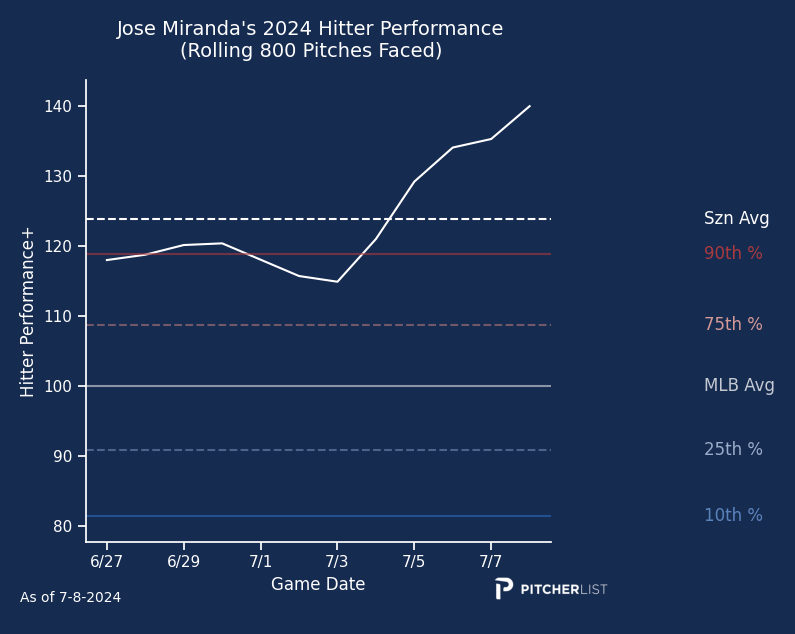
A season removed from a lingering shoulder injury, Miranda has shown big gains in power (106; 209 BBE) while maintaining above-average contact ability (108). The Twins will need him to keep producing with Royce Lewis on the shelf.
First Base
Is this the beginning of the end for one of this generation’s best first basemen? We’re 87 games in, and Paul Goldschmidt is hitting .229 with a .662 OPS, far below his previous career lows of .260 (2019) and .810 (2023). We’ve seen Goldy go on binges before and the silver lining is that his contact ability (94) and power (112; 231 BBE) are comparable to last year’s (92) and (114; 423 BBE).
Vladimir Guerrero Jr.’s lukewarm power was a thing early on, but it’s not anymore (110; 276 BBE). That’s a good increase from last year (102; 498 BBE).
I’ll admit, part of me feels like Christian Walker is overperforming, but at the same time, his batted ball data is astounding (131 power; 250 BBE).
Andrew Vaughn might break last year’s career-best 21 home runs. Yeah, I can hear the yawns. But I’m a little interested given he’s shown some modest gains in power (112; 240 BBE) up from (105; 431 BBE).
The Yankees have had difficulty generating any offense outside of Judge and Juan Soto. Is Ben Rice the answer? The sample size is way too small (256 pitches faced), but to get an idea, he’s shown a good eye, made impressive swing decisions (133 SZ Judgement, 114 DV), and added power (121; 45 BBE).
Shortstop
Anthony Volpe began the year looking like he might be on the verge of a breakout with a notable gain in contact ability (104; 90 last year). However, he flamed out as the Yankees’ leadoff hitter as we saw big losses in FB rate (-11.5%) and Pull rate (-15.5%) drag his power from (106; 374 BBE) to (88; 286 BBE). Volpe’s plate approach also suffered with his DV dropping from 105 to 93. Maybe there’s another chicken parm session in the wings during the ASB, but this is setting up 2025 as a make-or-break year to prove he can be a big-league-caliber hitter.
Like Torres, Bo Bichette is another proven player who has fallen hard with a .607 OPS, the fourth-worst among qualified hitters. I’ve mentioned Bichette here before, still, seeing him down this low is something else. Can he make better swing decisions (80 DV) in the second half and salvage his season?
Bobby Witt Jr.’s power has boomed from 113 (517 BBE) to 124 (295 BBE) while maintaining superb contact ability (115). Pitchers are frightened, as they should be.
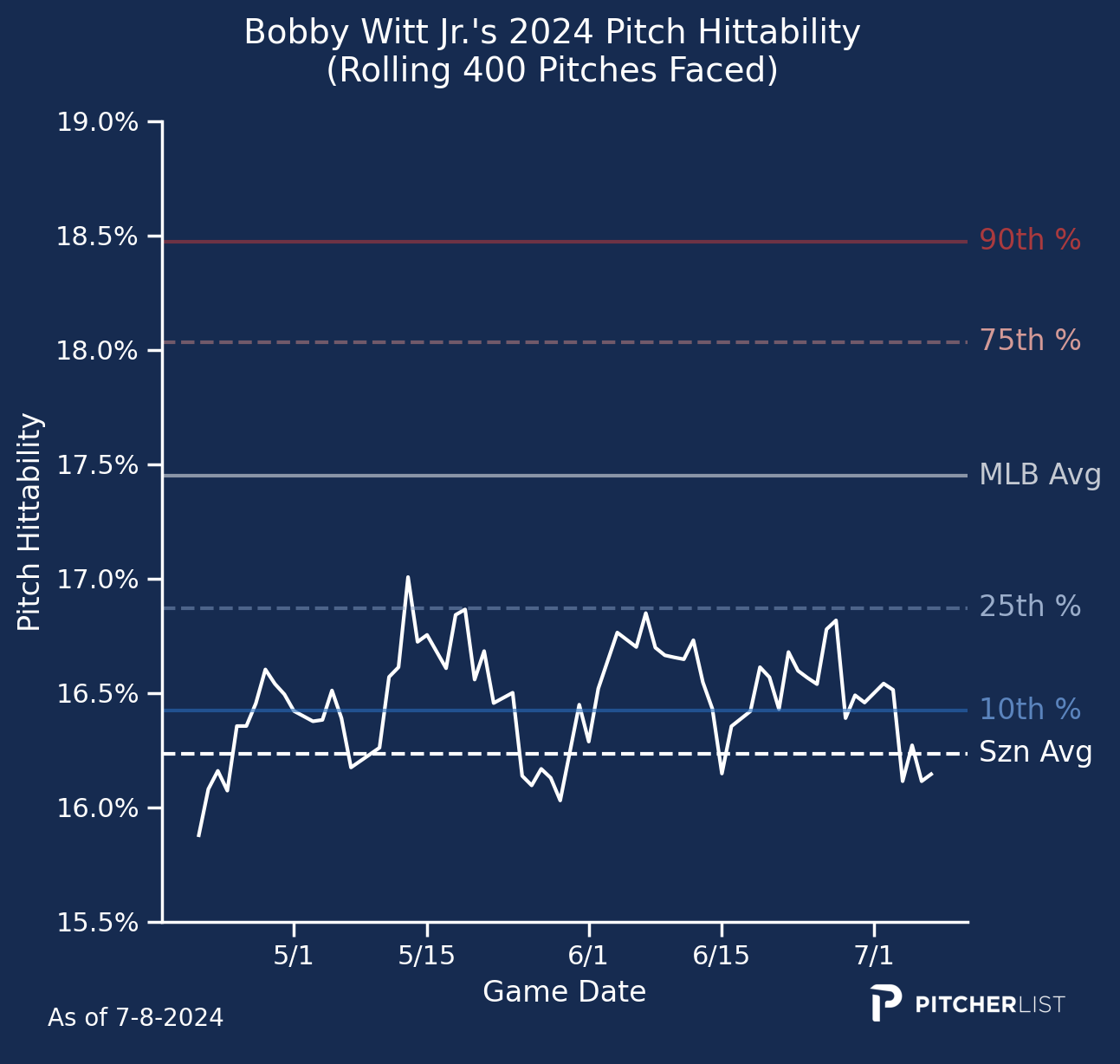
CJ Abrams‘ swing decisions are a little rough (81 DV). But that’s nitpicking. He’s a fantasy tank whose power has skyrocketed this year (113; 251 BBE).
Catcher
The Angels have at least one bright spot in Logan O’Hoppe. Fifth among qualified C’s with a .794 OPS, the former Philly prospect has shown impressive pop (118; 189 BBE).
Proven catchers Willson Contreras and Sean Murphy were knocked out of action but have since returned. Murphy’s PLV profile was one I waxed poetic about this past offseason. I certainly wouldn’t rule out a big finish for Murphy, but Willson’s profile is even stronger. The Cardinals’ backstop has shown excellent swings and takes (123 DV) with exemplary power (118; 101 BBE) even better than last year’s marks of 107 and 113 respectively.
Relief Pitchers
I’ve neglected relievers so far since it takes them a bit to get the 500 pitches we like for a sample size, but we’re starting to get there. Among pitchers with at least 500 pitches, Emmanuel Clase is at the top with a 5.67 PLV. Yennier Cano is next a 5.62, followed by my vote for this year’s reliever breakout: Griffin Jax. You’d be hard-pressed to find a better closer handcuff. Behold the goodness.
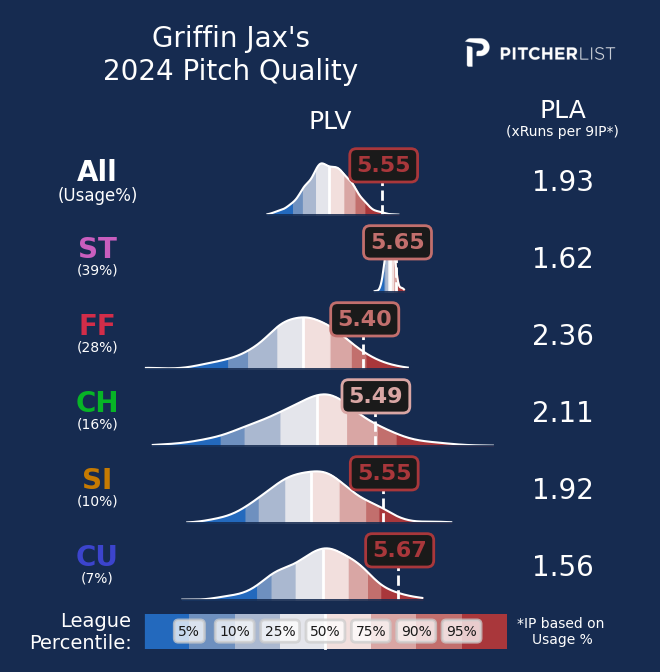
Photos by Mark Goldman/Icon Sportswire and Marcel Straub/Unsplash | Featured Image by Ethan Kaplan (@DJFreddie10 on Twitter and @EthanMKaplanImages on Instagram)

